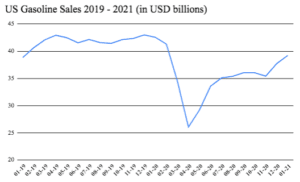 While 2020’s sales for fuel from US gasoline stations remained lower than previous years, trends show a rebound and return to 2019 levels in the near future. It’s clear that while consumer confidence may still be waning as a result of the global pandemic, consumers are getting back to work and resuming more “normal” patterns of behavior using COVID-related safety protocols. What this means for gas station and convenience store owners is that providing fuel for your customers is as important now as ever in 2021. The difference this year is that most businesses are feeling additional pressure to achieve results with greater efficiency than before. One area to examine is your fuel delivery service.
While 2020’s sales for fuel from US gasoline stations remained lower than previous years, trends show a rebound and return to 2019 levels in the near future. It’s clear that while consumer confidence may still be waning as a result of the global pandemic, consumers are getting back to work and resuming more “normal” patterns of behavior using COVID-related safety protocols. What this means for gas station and convenience store owners is that providing fuel for your customers is as important now as ever in 2021. The difference this year is that most businesses are feeling additional pressure to achieve results with greater efficiency than before. One area to examine is your fuel delivery service.
Here are a few steps we recommend for business owners:
- Define your requirements. If you haven’t reviewed your sales trends and customer information recently, now’s the time to take a deep dive. Identify how much fuel and what types of products your customers need. Having too much or too little inventory on hand results in inefficiencies and losses.
If you have the option of providing branded or unbranded fuel, take some time to consider the pros and cons of each to decide what’s best for your company. Your fuel delivery service should be able to help you review your company’s information and create a plan to make sure you always have the right amount of product to meet your customers’ demands.
- Consider the full range of services. Fuel delivery isn’t just about putting gasoline in your service station tanks. Most companies offer a range of services such as on-site fleet fueling, cardlock fleet fueling, generator fueling, and providing lubricants and chemicals. A good service should act as your business partner and be a one-stop solution for all of your business’ needs.
- Dig into the pricing agreement. Fuel is a commodity where your success or failure can come down to price. There is a multitude of ways fuel delivery companies price their products. Make sure you fully understand the pricing model and feel the company you’re working with is transparent about the actual costs you will experience. If in doubt, don’t hesitate to ask for references and contact a few of their clients to learn about their experiences.
- Examine servicing speed. None of the items above mean much if you can’t actually get the product you need on time. Review information about the company’s service area, including their distribution hubs and routes. Ask how many trucks they have available and how frequently they travel near your locations. Another important consideration is how quickly they can fulfill emergency orders.
Our H&S Energy Group team is proud to serve clients in Idaho, Washington, Oregon, and California. With decades of experience in the fueling industry, our staff works directly with business owners to help them implement products and services to outpace the competition and drive profitability over the finish line. Contact us today to learn more about how the power of H&S Energy Group can put your company in the Winner’s Circle.




